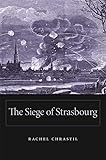The Siege of Strasbourg / Rachel Chrastil.
Material type: TextPublisher: Cambridge, MA : Harvard University Press, [2014]Copyright date: ©2014Description: 1 online resource (302 p.) : 14 halftones, 3 mapsContent type:
TextPublisher: Cambridge, MA : Harvard University Press, [2014]Copyright date: ©2014Description: 1 online resource (302 p.) : 14 halftones, 3 mapsContent type: - 9780674728868
- 9780674416284
- 944.3954
- DC308 .C47 2014
- DC801.S77
- online - DeGruyter
- Issued also in print.
| Item type | Current library | Call number | URL | Status | Notes | Barcode | |
|---|---|---|---|---|---|---|---|
 eBook
eBook
|
Biblioteca "Angelicum" Pont. Univ. S.Tommaso d'Aquino Nuvola online | online - DeGruyter (Browse shelf(Opens below)) | Online access | Not for loan (Accesso limitato) | Accesso per gli utenti autorizzati / Access for authorized users | (dgr)9780674416284 |
Frontmatter -- Contents -- Note to the Reader -- Introduction -- Chapter one. The Grey Areas -- Chapter two. Insiders and Outsiders -- Chapter three. Every Twenty Seconds -- Chapter four. Victims in the Eye of the Beholder -- Chapter five. Carrying On -- Chapter six. A Fraternal Hand -- Chapter seven. Heroic Measures -- Chapter eight. Strassburg -- Conclusion -- Abbreviations -- Notes -- Acknowledgments -- Index
restricted access online access with authorization star
http://purl.org/coar/access_right/c_16ec
When war broke out between France and Prussia in the summer of 1870, one of the first targets of the invading German armies was Strasbourg. From August 15 to September 27, Prussian forces bombarded this border city, killing hundreds of citizens, wounding thousands more, and destroying many historic buildings and landmarks. For six terror-filled weeks, "the city at the crossroads" became the epicenter of a new kind of warfare whose indiscriminate violence shocked contemporaries and led to debates over the wartime protection of civilians. The Siege of Strasbourg recovers the forgotten history of this crisis and the experiences of civilians who survived it. Rachel Chrastil shows that many of the defining features of "total war," usually thought to be a twentieth-century phenomenon, characterized the siege. Deploying a modern tactic that traumatized city-dwellers, the Germans purposefully shelled nonmilitary targets. But an unintended consequence was that outsiders were prompted to act. Intervention by the Swiss on behalf of Strasbourg's beleaguered citizens was a transformative moment: the first example of wartime international humanitarian aid intended for civilians. Weaving firsthand accounts of suffering and resilience through her narrative, Chrastil examines the myriad ethical questions surrounding what is "legal" in war and what rights civilians trapped in a war zone possess. The implications of the siege of Strasbourg far exceed their local context, to inform the dilemmas that haunt our own age--in which collateral damage and humanitarian intervention have become a crucial part of our strategic vocabulary.
Issued also in print.
Mode of access: Internet via World Wide Web.
In English.
Description based on online resource; title from PDF title page (publisher's Web site, viewed 30. Aug 2021)


